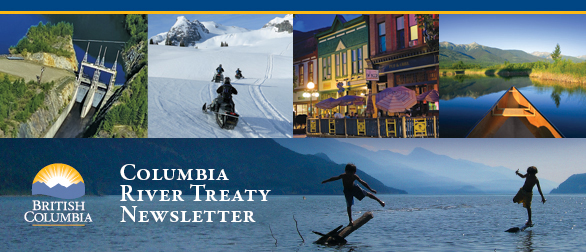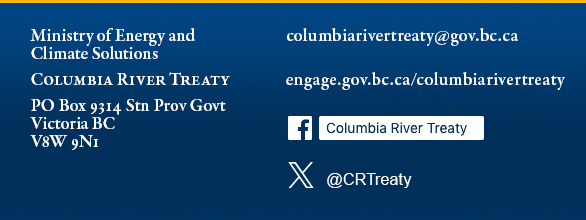Columbia River Treaty
Edition: April 2021

Exploring the feasibility of building a weir on Koocanusa Reservoir
Apr 27, 2021
An upcoming report by the Province of B.C. will summarize recent efforts to explore the feasibility of building a weir across Koocanusa Reservoir, along with the Province’s assessment of the issue.
In 2019, a group of local residents petitioned the B.C. Columbia River Treaty Team to consider building a weir across the reservoir, in order to maintain a higher minimum reservoir elevation from May to September. The request was due to ongoing concerns about summer changes to Koocanusa water levels and their impact on recreation and tourism on the Canadian side of the reservoir. Water levels rise and fall as a result of the U.S. Army Corps of Engineers’ operations at Libby Dam on the U.S. side of the border. The Province commissioned an independent study by BGC Engineering Inc. that took a preliminary, high-level look at both positive and negative impacts and costs of the proposed water control structure.
BGC’s report concluded that while building a weir could improve recreation and tourism opportunities on the Canadian side of the border, it may have a negative effect on hydropower generation, fisheries and flood management in the U.S., as well as downstream along the Kootenay River in B.C., depending on whether reservoir elevations would be maintained annually or seasonally. The report also estimated that building a weir/dam could cost over $400 million, possibly up to $1 billion given that it would be submerged during a large portion of the year. In addition, yearly operating and maintenance costs could range from $560,000 and $1,400,000 or more.
The BGC report was released in January, 2020, after which the B.C. Columbia River Treaty Team hosted a public virtual town hall, to share results and seek feedback. The study lead, Hamish Weatherly, presented his findings and answered questions, alongside Kathy Eichenberger, lead of the B.C. Treaty Team. Close to 150 people attended the session, offering comments and feedback. They shared their thoughts on topics such as preferred reservoir elevation levels, the need for broad consultation before further consideration is given to the weir or dam, the costs involved, and the location of the weir.
Feedback on the report was accepted by email and mail, up to mid-February, much of which echoed comments raised during the town hall. Two substantial submissions highlighted concerns about the ecological consequences a weir or dam would have, and emphasized that, should this proposal be considered further, a system-wide assessment of impacts would need to be conducted. All feedback is summarized in the Province’s assessment report which will be released on the Province’s Columbia River Treaty website in the near future.
As this conceptual proposal is at a very early stage, it is understood that extensive consultation with Indigenous Nations would be required should a decision be made to advance this project.


